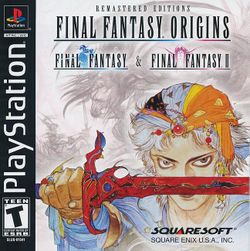The wiki is lacking in content. You can help by creating a new article. See the to do list for more ways you can help.
New user registration has been restored. Thank you for your patience.
Welcome Indie Wiki Jammers! Check out here for info on the jam
Final Fantasy Origins
| Final Fantasy Origins | |
|---|---|

| |
|
ファイナルファンタジーI・II プレミアムパッケージ | |
| Developer(s): | |
| Publisher(s): |
|
| Platform(s): | |
| Release date: | |
| Genre: |
Role-playing game |
| Modes: |
Single player |
| Ratings: |
ESRB: T (Teen) |
| This article uses content from Wikipedia (view authors), and falls under the compatible Creative Commons license. |
Final Fantasy Origins is a compilation title for the PlayStation. It has enhanced remakes of the first two Final Fantasy games, Final Fantasy and Final Fantasy II. The PlayStation versions were first released in Japan in 2002. Each game was either sold separately, or combined in the form of the Final Fantasy I & II Premium Package, a special edition that included three collector's figurines with the game. This collection, sans special packaging and figurines, was next released in Europe as Final Fantasy Origins in 2003. Later that year, Final Fantasy Origins was released in North America and included both games on a single disc.
Final Fantasy Origins was the first time that Final Fantasy II officially released in North America and the first time that both games released in Europe.
Audio[edit]
The soundtracks have been enhanced to Final Fantasy IX quality from their original NES or WonderSwan Color representations. The games have both undergone gameplay streamlining. The Final Fantasy Origins versions of Final Fantasy and Final Fantasy II are based on the WonderSwan Color versions. The upgraded soundtrack for Final Fantasy was arranged by Nobuo Uematsu, while the upgraded soundtrack for Final Fantasy II was arranged by Tsuyoshi Sekito.
Differences from originals[edit]
Both games have enhanced graphics, remixed soundtracks, added computer-generated FMV cutscenes, and added content. It also includes art galleries of Yoshitaka Amano's illustrations. This was the first time Final Fantasy II was released in the West.
As for the tomb at Elfheim (or Elf Land on the NES version), the tomb reads "Here lies Erdrick" on the American NES version of Final Fantasy I, a reference to the Dragon Warrior game. It reads "May Link rest in peace," on the American Final Fantasy Origins and the original Japanese NES version of Final Fantasy I, a reference to the main character of The Legend of Zelda series. It reads "May Erdrick rest in peace," on the PAL Final Fantasy Origins version. (Interestingly, the text referencing Link was only slightly changed in Final Fantasy I & II: Dawn Of Souls, even though that version was made for a Nintendo system. In DoS, it reads "Here lies Link.")
While the NES version of Final Fantasy has only one save slot and the WonderSwan Color version has only eight, the Final Fantasy Origins version has as many save slots as the PlayStation's Memory Card allows.
Other versions[edit]
Final Fantasy and Final Fantasy II were first packaged together in 1994, when both games were combined onto a single Famicom cartridge and released as Final Fantasy I-II. As both games had originally appeared on the Famicom, there were no substantial changes between the originals and the compilation versions.
The PlayStation versions of the game were most similar to the WonderSwan Color remakes that were produced separately in 2000 and 2001, respectively. Other than minor changes to take advantage of Sony's superior hardware, such as a higher screen resolution which meant that the graphics in the PlayStation version were slightly more detailed, and the remixed soundtracks, the PlayStation versions were basically identical to the earlier WonderSwan versions.
The remakes were later put onto the same cartridge when they were ported to the Game Boy Advance as Final Fantasy I & II: Dawn of Souls (known as Final Fantasy I & II Advance in Japan). The port featured similar graphics and sound to the PlayStation version (though slightly inferior due to the Game Boy Advance's capabilities). The Game Boy Advance version of Final Fantasy I contains four extra dungeons featuring bosses from later Final Fantasy titles, plus a few gameplay tweaks (including an MP system and easier difficulty setting). This version of Final Fantasy II included an extra side-story after finishing the game but the overall gameplay was not altered from the PlayStation version.
Sweepstakes[edit]
From March 7–20, 2003, Squaresoft held a sweepstakes for Final Fantasy Origins.[2] There were over 27,000 participants. The grand prize winner, who was Albert Jones, got:
- A copy of Final Fantasy Origins and its official strategy guide.
- A copy of Final Fantasy Anthology and its official strategy guide.
- A copy of Final Fantasy Chronicles and its official strategy guide.
- The art catalog Think Like Amano and Dawn, another art collection from Yoshitaka Amano.
Five other participants got the first place prize, which only consisted of the main two items of the sweepstakes, a copy of Final Fantasy Origins and its BradyGames guide.
External links[edit]
 Final Fantasy Origins on MobyGames
Final Fantasy Origins on MobyGames- North American website (archived)